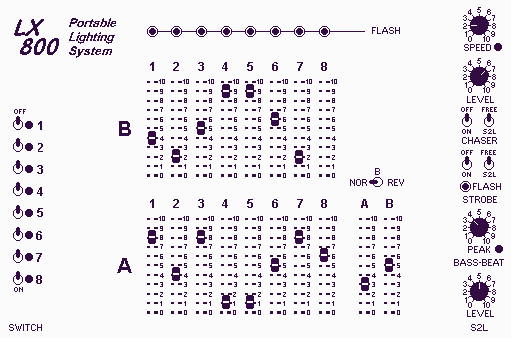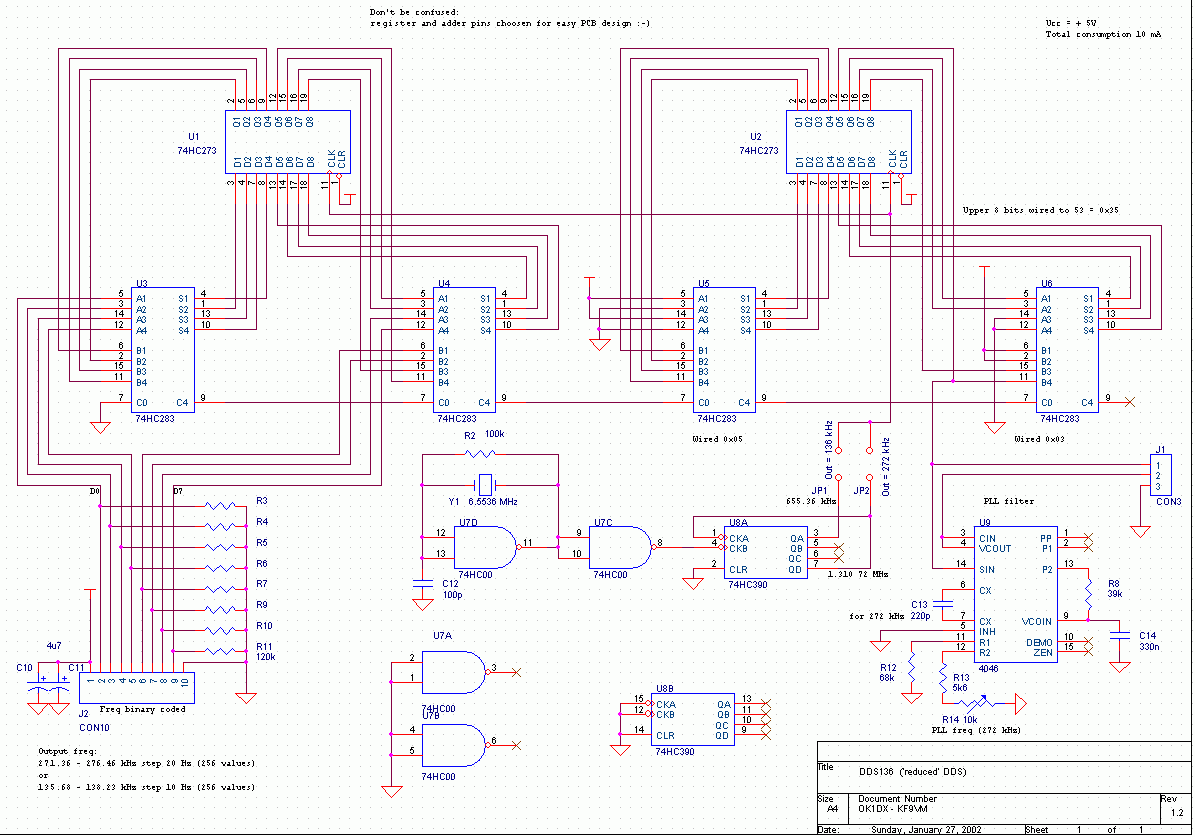
Simple Alarm System

The circuit presented is a simple yet effective alarm system designed to protect an object. It requires no specialized devices and can be constructed using commonly available components. The primary alarm-triggering element is a reed switch. Any optical or acoustic device operating on 12 V, such as a revolving light or siren, can be used to generate the alarm signal. In the quiescent state, the reed switch remains closed. When the reed switch opens, the input to IC1.B goes low, as the potential divider formed by R2 and R3 previously held the input at 5.17 V, indicating a logic high level. A turn-on delay of 0 to approximately 90 seconds can be set using potentiometer P1, while a turn-off delay of 0 to approximately 20 seconds can be set using P2. When the system is activated via switch S1, the turn-on delay begins, allowing the user up to 90 seconds to leave the object unattended before the system arms itself. If the reed switch opens, the turn-off delay starts, providing the rightful owner time to deactivate the system before the alarm is triggered. If an unauthorized individual opens the reed switch, the alarm will activate after the turn-off delay. The alarm will also trigger if the reed switch is briefly opened and then closed again. Once triggered, T3 will conduct for about 45 seconds due to R8 and C5, preventing nuisance alarms. The system then returns to the armed state, ready to trigger again upon the next opening of the reed switch. If a continuous alarm is desired, D5 should not be installed. The system can be expanded by connecting multiple reed switches in series; triggering any one of them will activate the alarm. When S1 is closed, C3 charges through P1, taking between 0 and 90 seconds to reach the input threshold voltage of IC1.A. The output of IC1.A then goes low, stopping D3 from conducting. If the reed switch remains closed, the inputs of IC1.B remain high, keeping its output low. If the reed switch is opened after the turn-on delay, the output of the gate changes state, activating T1, which maintains the high output even if the reed switch is closed again. C4 charges through P2, reaching the input threshold voltage of IC1.C in about 20 seconds, depending on the potentiometer setting. The output of IC1.C then goes low, turning on T2 and T3, causing the siren to sound. Any Darlington transistor can be used for T3. Simultaneously, C5 charges through R8, reaching the input threshold of IC1.D in approximately 45 seconds. When IC1.D's output swings low, it pulls the inputs of IC1.A low via diode D5, stopping the siren and returning the system to the armed state. By replacing the potentiometers P1 and P2 with fixed resistors, the circuit can be miniaturized to fit within a matchbox, making it suitable for protecting a motorcycle. For use in a car, an existing door switch contact can replace the reed switch, necessitating the addition of an RC combination to prevent false triggering. A 10 µF/25 V electrolytic capacitor (C6), a 100 kΩ resistor (R9), and a 1N4001 diode (D7) should be used in this configuration. Multiple door switch contacts can be wired in parallel, triggering IC1.B when any one contact closes.The circuit presented here is a very simple and yet highly effective alarm system for protecting an object. The circuit requires no special devices and can be built using components that you will no doubt be able to find in the junk box.
The alarm-triggering element is a simple reed switch. To generate the alarm signal itself any optical or acoust ic device that operates on 12 V can be used: for example a revolving light, a siren, or even both. In the quiescent state the reed switch is closed. As soon as the reed switch opens, the input to IC1. B will go low (previously the potential divider formed by R2 and R3 held the input at 5. 17 V, a logic high level). A turn-on delay of between 0 and approximately 90 s can be set using P1, and a turn-off delay of between 0 and approximately 20 s can be set using P2. When the system is turned on (using S1), the turn-on delay is activated, giving the user of the system at most 90 s to leave the object alone before the system goes into the armed state, and the object is then protected.
Once the reed switch opens the turn-off delay of at most 20 s starts: this allows the rightful owner of the object to turn the system off before the alarm is triggered. If some unauthorised person causes the reed switch to open, the alarm will be triggered after the turn-off delay.
Also, even if the reed switch is briefly opened and then closed again, the alarm will still be triggered. Once the alarm is triggered, T3 will conduct for about 45 s (because of R8 and C5). The turning off of the alarm is necessary to avoid the nuisance caused by a permanently sounding alarm system.
The system then returns to the armed state, which means that the next time the reed switch is opened the alarm will trigger again. If it is not desired that the duration of the alarm be limited, for example if a visual indication is used, D5 should not be ¬tted.
The system can be extended by ¬tting multiple reed switches in series. As soon as any one is opened, the alarm is triggered. When S1 is closed C3 charges via P1. Depending on the potentiometer setting, it takes between 0 and 90 s to reach the input threshold voltage of IC1. A. The output of IC1. A then goes low and D3 stops conducting. Assuming the reed switch is closed, the inputs of IC1. B stay high and the output therefore low. If the reed switch is opened after the turn-on delay expires the output of the gate will change state and turn on T1.
This ensures that the output of the gate remains high even after the reed switch is closed again. C4 now starts charging via P2, reaching the input threshold voltage of IC1. C after between 0 and 20 s, again according to the potentiometer setting. The output of IC1. C goes low, and T2 and T3 are turned on and the siren sounds. Any Darlington transistor can be used for T3. At the same time, C5 charges via R8, reaching the input threshold of IC1. D in about 45 s. When the output of IC1. D swings low, it pulls the inputs of IC1. A low via diode D5: the siren stops and the system returns to the armed state. If the potentiometers P1 and P2 are replaced by ¬xed resistors it is possible to build the circuit small enough to ¬t in a match-box, without the need to resort to SMD components. This is ideal if the circuit is to be used to protect a motorbike. If the alarm system is to be used in a car, an existing door switch contact can be used instead of the reed switch.
In this case an RC combination needs to be added to prevent false triggering. Use a 10 µF/25 V electrolytic for C6, a 100 k © resistor for R9 and a 1N4001 for D7. It is again possible to wire multiple door switch contacts in parallel: as soon as one contact closes, IC1. B will be triggered. 🔗 External reference
The alarm-triggering element is a simple reed switch. To generate the alarm signal itself any optical or acoust ic device that operates on 12 V can be used: for example a revolving light, a siren, or even both. In the quiescent state the reed switch is closed. As soon as the reed switch opens, the input to IC1. B will go low (previously the potential divider formed by R2 and R3 held the input at 5. 17 V, a logic high level). A turn-on delay of between 0 and approximately 90 s can be set using P1, and a turn-off delay of between 0 and approximately 20 s can be set using P2. When the system is turned on (using S1), the turn-on delay is activated, giving the user of the system at most 90 s to leave the object alone before the system goes into the armed state, and the object is then protected.
Once the reed switch opens the turn-off delay of at most 20 s starts: this allows the rightful owner of the object to turn the system off before the alarm is triggered. If some unauthorised person causes the reed switch to open, the alarm will be triggered after the turn-off delay.
Also, even if the reed switch is briefly opened and then closed again, the alarm will still be triggered. Once the alarm is triggered, T3 will conduct for about 45 s (because of R8 and C5). The turning off of the alarm is necessary to avoid the nuisance caused by a permanently sounding alarm system.
The system then returns to the armed state, which means that the next time the reed switch is opened the alarm will trigger again. If it is not desired that the duration of the alarm be limited, for example if a visual indication is used, D5 should not be ¬tted.
The system can be extended by ¬tting multiple reed switches in series. As soon as any one is opened, the alarm is triggered. When S1 is closed C3 charges via P1. Depending on the potentiometer setting, it takes between 0 and 90 s to reach the input threshold voltage of IC1. A. The output of IC1. A then goes low and D3 stops conducting. Assuming the reed switch is closed, the inputs of IC1. B stay high and the output therefore low. If the reed switch is opened after the turn-on delay expires the output of the gate will change state and turn on T1.
This ensures that the output of the gate remains high even after the reed switch is closed again. C4 now starts charging via P2, reaching the input threshold voltage of IC1. C after between 0 and 20 s, again according to the potentiometer setting. The output of IC1. C goes low, and T2 and T3 are turned on and the siren sounds. Any Darlington transistor can be used for T3. At the same time, C5 charges via R8, reaching the input threshold of IC1. D in about 45 s. When the output of IC1. D swings low, it pulls the inputs of IC1. A low via diode D5: the siren stops and the system returns to the armed state. If the potentiometers P1 and P2 are replaced by ¬xed resistors it is possible to build the circuit small enough to ¬t in a match-box, without the need to resort to SMD components. This is ideal if the circuit is to be used to protect a motorbike. If the alarm system is to be used in a car, an existing door switch contact can be used instead of the reed switch.
In this case an RC combination needs to be added to prevent false triggering. Use a 10 µF/25 V electrolytic for C6, a 100 k © resistor for R9 and a 1N4001 for D7. It is again possible to wire multiple door switch contacts in parallel: as soon as one contact closes, IC1. B will be triggered. 🔗 External reference
Warning: include(partials/cookie-banner.php): Failed to open stream: Permission denied in /var/www/html/nextgr/view-circuit.php on line 713
Warning: include(): Failed opening 'partials/cookie-banner.php' for inclusion (include_path='.:/usr/share/php') in /var/www/html/nextgr/view-circuit.php on line 713





